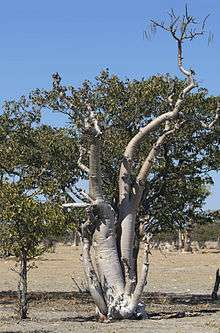Moringa
Moringa, native to parts of Africa and Asia, is the sole genus in the flowering plant family Moringaceae. The name is derived from murungai, the Tamil word for drumstick, and the plant is commonly referred to as the drumstick tree.[4] It contains 13 species from tropical and subtropical climates that range in size from tiny herbs to massive trees. Moringa species grow quickly in many types of environments.
| Moringa | |
|---|---|
 | |
| M. ovalifolia in Namibia | |
| Scientific classification | |
| Kingdom: | Plantae |
| Clade: | Tracheophytes |
| Clade: | Angiosperms |
| Clade: | Eudicots |
| Clade: | Rosids |
| Order: | Brassicales |
| Family: | Moringaceae Martinov[1] |
| Genus: | Moringa Adans.[2] |
| Type species | |
| Moringa oleifera | |
| Species | |
|
See text | |
| Synonyms | |
|
Donaldsonia Baker f. | |
The most widely cultivated species is Moringa oleifera, native to the foothills of the Himalayas in northwestern India,[5] a multipurpose tree cultivated throughout the tropics and marketed as a dietary supplement, health food or source for herbalism practices.[6] The fruit pods of Moringa oleifera ("drumsticks") are consumed as food in many parts of the world, but particularly in South Asia. The leaves are commonly used to make tea. Oils are made from the seeds, while powders can be made from the leaves and roots.
M. stenopetala, an African species, is also widely grown, but to a much lesser extent than M. oleifera.
List of species
- Moringa arborea Verdc. (indigenous to Kenya)[7]
- Moringa borziana Mattei (indigenous to Somalia)[7]
- Moringa concanensis Nimmo (indigenous to northern India)[7]
- Moringa drouhardii Jum. – bottle tree (indigenous to southwestern Madagascar)[7]
- Moringa hildebrandtii Engl. – Hildebrandt's moringa (indigenous to southwestern Madagascar)[7]
- Moringa longituba Engl. (indigenous to Ethiopia and Somalia)[7]
- Moringa oleifera Lam. (syn. M. pterygosperma) – horseradish tree (indigenous to northwestern India)[7]
- Moringa ovalifolia Dinter & Berger (indigenous to Namibia and Angola)[7]
- Moringa peregrina (Forssk.) Fiori[8] indigenous to Arabian Peninsula Horn of Africa and in the Southern Sinai, Egypt[7][9]
- Moringa pygmaea Verdc. (indigenous to Somalia)[7]
- Moringa rivae Chiov. (indigenous to Kenya and Ethiopia)[7]
- Moringa ruspoliana Engl. (indigenous to Ethiopia)[7]
- Moringa stenopetala (Baker f.) Cufod.[10][11] (indigenous to Kenya and Ethiopia)[7]
References
- Angiosperm Phylogeny Group (2009). "An update of the Angiosperm Phylogeny Group classification for the orders and families of flowering plants: APG III" (PDF). Botanical Journal of the Linnean Society. 161 (2): 105–121. doi:10.1111/j.1095-8339.2009.00996.x. Retrieved 2013-07-06.
- "Genus: Moringa Adans". Germplasm Resources Information Network. United States Department of Agriculture. 1996-09-17. Archived from the original on 2015-09-24. Retrieved 2011-09-26.
- "Moringa Adans". TROPICOS. Missouri Botanical Garden. Retrieved 2009-12-30.
- Singh, Maavi. "My Mom Cooked Moringa Before It Was A Superfood". NPR.org. Retrieved 2019-02-14.
- Olson, Mark (2010). "Moringaceae Martinov. Drumstick Tree Family" (PDF). Flora of North America. 1993+. Flora of North America North of Mexico. 7: 167–169.
- Janick, Jules; Robert E. Paull (2008). The Encyclopedia of Fruit & Nuts. CABI. pp. 509–510. ISBN 978-0-85199-638-7.
- Leone A, Spada A, Battezzati A, Schiraldi A, Aristil J, Bertoli S (2015). "Cultivation, Genetic, Ethnopharmacology, Phytochemistry and Pharmacology of Moringa oleifera Leaves: An Overview". International Journal of Molecular Sciences. 16 (6): 12791–12835. doi:10.3390/ijms160612791. PMC 4490473. PMID 26057747.
- Dadamouny, M.A. (2009). (2009). Population Ecology of Moringa peregrina growing in Southern Sinai, Egypt (M.Sc.). doi:10.13140/RG.2.1.5091.9760. Retrieved 2009-12-26.
- Dadamouny, Mohamed A.; Unterseher, Martin; König, Peter; Schnittler, Martin (December 2016). "Population performance of Moringa peregrina (Forssk.) Fiori (Moringaceae) at Sinai Peninsula, Egypt in the last decades: Consequences for its conservation". Journal for Nature Conservation. 34: 65–74. doi:10.1016/j.jnc.2016.08.005.
- "Subordinate Taxa of Moringa Adans". TROPICOS. Missouri Botanical Garden. Retrieved 2009-12-30.
- Dadamouny, Mohamed A.; Zaghloul, Mohamed S.; Ashraf, Salman (2012). "Impact of Improved Soil Properties on Establishment of Moringa peregrina seedlings and trial to decrease its Mortality Rate". Egyptian Journal of Botany. Retrieved 2012-07-03.
External links
| Wikimedia Commons has media related to Moringa. |
| Wikispecies has information related to Moringa |
- Moringa Home Page, Instituto de Biología, Universidad Nacional Autónoma de México
- The International Moringa Germplasm Collection